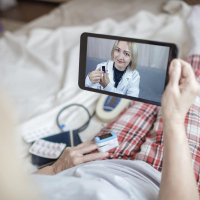
Do telehealth technologies help improve the health of people who have COPD?
For the full review click here.
Background
Chronic obstructive pulmonary disease (COPD) includes a group of lung conditions that cause breathing difficulties. Symptoms include shortness of breath (dyspnoea), coughing, and increased mucus. COPD causes limited airflow in the lungs when breathing out; this can be measured by spirometry (a measure to assess how well the lungs function). The spirometer takes two measurements: volume of air when breathing out forcefully in one second, and total amount of air breathed out. When COPD gets worse over time, this leads to greater symptom severity and can reduce quality of life. Disease progression and sudden flare‐ups (exacerbations) of symptoms can increase someone's risks of hospitalisation and death. Telehealth technologies could improve delivery of health care for people with COPD, which could reduce exacerbations, improve quality of life, and lower rates of hospitalisation. However, it is unclear whether providing telehealth care improves health‐related outcomes for people with COPD. We wanted to explore whether telehealth technologies were helpful for people with COPD.
What are telehealth technologies?
Study investigators used a range of telehealth technologies. Some included remote monitoring technology, which requires daily use of a laptop or a tablet with monitoring equipment, with results received by the healthcare professional. Typical monitoring equipment included a stethoscope (to measure blood pressure and heart rate), a pulse oximeter (to measure oxygen levels in the blood), a spirometer (to measure lung function), a thermometer, and other devices. Interventions involved regular phone calls with healthcare professionals for patients to talk about their symptoms and completion of health questionnaires.
Identifying and selecting studies
We searched online databases up until April 2020. We searched for studies published worldwide, in any language, at any time. Two review authors looked at lists of studies separately, then agreed on which studies should be included.
To find the best answer to our question, we looked for studies that recruited people with COPD of any severity. To make the comparison fair, we looked for studies in which investigators compared remote monitoring, remote monitoring plus usual care, and multi‐component treatments. People included in these studies had to have the same random chance (like the flip of a coin) to receive one of these teleheath technologies or usual care.
Key results
We found 29 studies (5654 people with moderate to very severe COPD) that were suitable for inclusion in our review. Duration of these studies ranged from 3 to 12 months.
We did not find any important benefits or harms for patients who were monitored with any of the telehealth technologies when we looked at number of exacerbations, improvement in quality of life, and reduction in breathing distress symptoms, hospitalisations, or death. However, people who were monitored through telehealth technology plus usual care had some reduction in risk of hospital re‐admission. Thus, telehealth technologies that were part of a care package reduced COPD‐related hospital re‐admissions.
We could not be certain of any harms of stand‐alone remote monitoring. We are also uncertain of any benefits or harms of stand‐alone remote monitoring of patient experiences or reports of breathing distress.
Quality of evidence
Currently, no good quality evidence is available. We are very uncertain about evidence for exacerbations, quality of life, dyspnoea symptoms, hospitalisations, deaths, and side effects. However, we are moderately certain about our findings for hospital re‐admissions.
Conclusion
We are not clear whether telehealth technologies for monitoring or consultation provide benefit, but we have not found any information on harms. Telehealth could play a role in the care and management of people with COPD. Telehealth as part of multi‐component care packages may provide short‐term benefit for quality of life and hospital re‐admissions. Telehealth in the form of remote monitoring in addition to usual care may reduce the risk of hospital re‐admission. There is little impact on exacerbations, quality of life, and death. Owing to limited information, the findings of this review should be interpreted with caution. More studies are needed to determine whether telehealth provides any long‐term benefits for people with COPD of varying severity.
Read the full review here.
